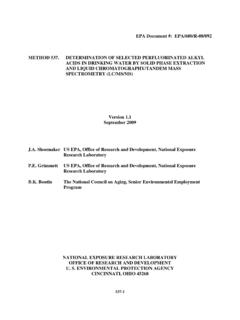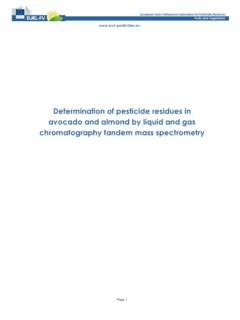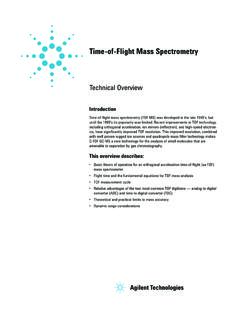Transcription of Quantification of Tentatively Identified Extractables and ...
1 Quantification of Tentatively Identified Extractables and Leachables with mass Spectrometry and Polyarc/FID. Application Note Chemical Characterization for Biocompatibility detection could apply to E&L studies, integrating a Author two-step process into a one-step analysis. Jianxin Yu, Ashley Baeten, Scott Citrowske Two XTI -5MS Columns were installed into the front Abbott Laboratories inlet of a 6890 GCMS. One of the columns was 177 East County Rd B connected to the 5975 mass Spectrometer while the St. Paul, MN 55117. other was connected to the PolyArc and FID. Two groups of known Extractables and leachables of concern were prepared in acetone solutions at Introduction concentrations ranging from 50 g/mL to 100 g/mL. These preparations were spiked with a known volume of internal standard at a concentration of 25. Extractable and Leachable (E&L) evaluations have g/mL before triplicate analysis on the instrument.
2 Become increasingly more vital to successful medical Calculation of the relative response factors of each device product development and regulatory analyte was performed with both the mass submissions. According to requirements and Spectrometer and PolyArc/FID data for comparison. guidance from the US Food and Drug Administration (FDA), European Medicines Agency (EMA), ISO and the Product Quality Research Institute (PQRI)[1-4], Experimental E&L profiles should be established by exhaustive extraction with multiple solvents of varying polarities GC conditions and reliable determination with distinctive analytical Front inlet Split/Splitless techniques. Split Flow 5:1. Inlet temperature 280 C. Gas chromatography mass spectrometry (GC-MS) Inlet pressure psi analysis with headspace (HS) or liquid injection Column Flow mL/min, Constant Flow detects volatile and semi volatile components in E&L Septum purge flow 3 mL/min studies.
3 Due to the complexity of materials and the Oven 40 C (2 min), 10 C/min to unpredictability of an E&L analysis, two-step analysis 310 C (7 min). (initial screening and target analysis) is usually Column XTI-5 (30 m mm . employed for qualification and Quantification of m). compounds detected. This is a costly, time- consuming and labor-intensive process. Syringe 10 L. Injection volume 1 L. The PolyArc/FID system converts carbon atoms of organic molecules found in the column effluent into FID conditions methane which then generates an FID response. The Temperature 300 C. resulting detector response is uniform on a per H2 mL/min carbon basis and allows the FID to have a truly Air 350 mL/min universal carbon sensitivity. This eliminates the need Makeup 20 mL/min (He). for calibration standards for each Identified Sampling rate 50 Hz compound to determine an internal or external standard's response factor. Gas chromatography using full scan MS combined with parallel PolyArc/FID.
4 |1. Polyarc reactor conditions Most of the E&Ls compounds of interest have a RRF. Setpoint 293 C above from the PolyArc/FID detection with very H2 35 mL/min low %RSD, while the RRFs from the MS range from Air mL/min to with a greater %RSD. It is common for an analyte's concentration to be semi-quantified by mass Spectrometer conditions the use of an internal, surrogate or standard. That is, Transfer Line an internal standard is added to a sample at a known 300 C. temperature concentration and the E&L analyte's concentration is EI, 70eV with 3 min solvent semi-quantified from the internal relative response. MS Detection The accuracy of such a concentration estimate delay depends on the similarity of the response of the Source 250 C method for the E&L analyte and the internal temperature standard. The more the RRF deviates from 1, the mass Range 33-650 amu less accurate the concentration estimate is. For example bisphenol A has demonstrated to have vastly different responses on the Polyarc/FID vs MS.
5 Results and Discussion detection. Table 1 shows a RRF of from the PolyArc/FID, which means the actual result is In this study, the relative response factor (RRF) was approximately times the calculated amount determined from both MS and PolyArc/FID response injected on the system. However, through MS. using the following equation: detection, bisphenol A's RRF is , thus the actual result would be times the calculated A x Ci amount injected. This difference in RRFs by RRF bisphenol A shows that if this were an unknown Ai Cx compound rather than one with an established RRF. Where: the MS detection would lead to a larger underestimate of concentration. An underestimation Ax = peak area of E&Ls of concentration could negatively impact your risk assessment making you think the analyte is safer Ai = peak area of internal standard than it really is. Cx = concentration of E&Ls (concentration g/mL for MS; moles of carbon for PolyArc/FID) An alternate adjustment could be adopted by generating a RRF database and applying to actual Ci = concentration of internal standard analysis, which could be extremely useful for those (concentration g/mL for MS; moles of carbon for E&L analytes like organic acids which show PolyArc/FID).
6 Significant suppression in MS and PolyArc/FID. In such a situation, the %RSD can be critical. The analysis was executed in three replicates and the PolyArc/FID shows better accuracy even for stearic average RRF and %RSD is reported and compared in acid analysis. Tables 1 and 2 below. Table 1: Relative Response Factors (RRF) for Group 1 E&Ls %RSD of RRF Average RRF from %RSD of RRF. Analytes Rt (min) RRF by MS from MS PolyArc from PolyArc 2-Fluorobiphenyl 6% 1%. IS (n-Hexadecane- D34) N/A N/A. bisphenol A 0% 0%. Dibutyl phthalate 4% 0%. DEHP 16% 1%. Erucamide 1% 1%. |2. Table 2: Relative Response Factors (RRF) for Group 2 E&Ls %RSD of %RSD of RRF Average RRF RRF from Analytes Rt (min) RRF by MS from MS from PolyArc PolyArc Heptanoic Acid 3% 1%. Undecanoic Acid 6% 0%. IS (n-Hexadecane- D34) N/A N/A. Myristic Acid 23% 2%. Diisopentyl phthalate 1% 1%. Stearic Acid 19% 2%. Hexacosane 22% 1%. Di-n-octyl phthalate 17% 1%.
7 Conclusions Contact Us Semi- Quantification of Tentatively Identified compounds is calculated using the relative area of For more information or to purchase a Polyarc . the tentative identification in relation to the relative system, please contact us at 612-787-2721 or area of the internal standard. Thus an ideal relative response factor for each tentative identification would be as close to as possible. The results Please visit their website for details and additional demonstrate that the Polyarc/FID system produces technical literature, relative response factors closer to ideal than the mass spectrometer across these known analytes tested. The incorporation of the Polyarc/FID system into E&L analysis would provide semi- Quantification that is more accurate giving more confidence to the risk assessment for biocompatibility. References 1. FDA's 510(K) Requirements sandMedicalProcedures/DeviceApprovalsan dClearances/510kClearances/.
8 2. EMA. Scientific Guidance, Guideline on Plastic Immediate Packaging Materials, 2005. 3. ISO-10993-12. 4. PQRI. Leachables and Extractables Working Group, Safety Thresholds and Best Practices for Extractables and Leachables in Orally Inhaled and Nasal Drug Products, 2006. |3.







